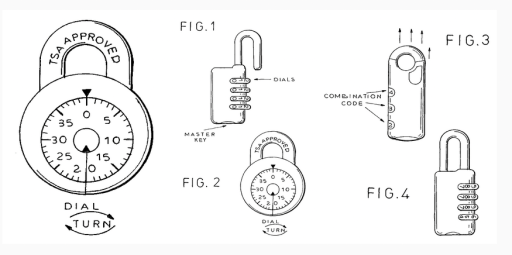CAFC Affirms District Court Finding that Dual-Access Lock Patents are Invalid Under 101
"The representative claim was ineligible because it described ‘basic steps of using and marketing a dual-access lock for luggage inspection, a long-standing fundamental economic practice and method of organizing human activity.’”

Dual-Access Lock
Source: U.S. Patent No. 7,021,537
On February 14, the U.S. Court of Appeals for the Federal Circuit (CAFC) affirmed the Eastern District of New York’s grant of summary judgment that inventor David Tropp’s patents were invalid because they claim ineligible subject matter under 35 U.S.C. § 101. The appeal was brought by Tropp against Travel Sentry, Inc. and other lock and luggage makers.
The asserted claims relate to U.S. Patent Nos. 7,021,537 (the ’537 patent) and 7,036,728 (‘728 patent). Representative claim 1 of the ’537 patent relates to a method of making available a dual-access lock having a combination-lock portion and a master-key-lock portion. The dual-access lock allegedly enables travelers to lock their bags while still allowing luggage screeners to access luggage (with a marked lock) with a master key.
The Representative Claim is Directed to an Abstract Idea
The district court held, and the CAFC agreed, that the representative claim was ineligible because it described “basic steps of using and marketing a dual-access lock for luggage inspection, a long-standing fundamental economic practice and method of organizing human activity.” Specifically, the district court held “the claim to be directed to an abstract idea, noting that our precedents consistently recognize the abstract character of such practices and methods.”
Further, the CAFC agreed with the district court that Tropp failed to identify an “inventive concept”, particularly the claim’s reference to a “special” lock. Tropp did not provide, in the claims or specification, “technical specification or concrete improvements.” Nor did he identify physical changes made to the lock to make the lock “special.”
The absence of this information only further supported the district court’s finding of the “generic nature” of the “special” lock. In addition, the district court noted that dual-access locks were “familiar and used in luggage screening, with bags identified by a tag to enable such use.” As a result, the district court held that “the claim fail[ed] to pass the muster under both steps of the eligibility inquiry.”
Argument Not Preserved
On appeal, Tropp argued that the representative claim is directed to “the creation of novel physical locks with a uniform master key (that works with a variety of locks that have different locking mechanisms).”
The CAFC noted that Tropp’s argument raised two substantial questions bearing on eligibility under Section 101: (1) did the claim require a dual-access lock in which the key for the master-key lock portion is the same for different combination-lock mechanisms?; and if so, (2) could the claim pass muster under Section 101 in the absence of anything in the specification, or even in the summary judgment record, that provides details regarding the physical makeup, mechanism, or operation of such a lock indicating a concrete technical advance over earlier dual-access locks?
However, the CAFC refused to address these questions because “Tropp [had] not preserved this argument for eligibility.” In his opposition to the Section 101 summary judgment motion, Tropp described the “special” lock as “having a combination lock portion and a master key lock portion” and the “identification structure” as the claimed improved “physical components.” But the CAFC noted Tropp failed in his opposition to argue that “the inventive concept in the claims was, or included, the creation of a new dual-access lock with a master key capable of opening dual-access locks whose combination-lock mechanisms differed from one another.”
The CAFC found Tropp’s argument for the Section 101 significance of the lock-mechanism improvement he claimed on appeal to be “materially different” from what he argued in his opposition to the Section 101 motion. Therefore, the CAFC “declined to upset the district court’s judgment based on an argument like this made for the first time on appeal.”
-
Previous:
-
Next:
This article has no related articles!






